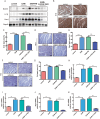Rho kinase inhibitor Y-27632 downregulates IL-1β expression in mice with experimental autoimmune myocarditis
- PMID: 38684719
- PMCID: PMC11058197
- DOI: 10.1038/s41598-024-60239-8
Rho kinase inhibitor Y-27632 downregulates IL-1β expression in mice with experimental autoimmune myocarditis
Abstract
Autoimmune myocarditis is the limited or diffuse inflammation of the myocardium due to dysfunctional cellular and humoral immunity mechanisms. We constructed mouse models of experimental autoimmune myocarditis (EAM) using peptide MyHC-α614-629. On the day after secondary immunization, the mice were intraperitoneally injected with Rho kinase (ROCK) inhibitor Y-27632. On day 21, the cardiac tissues were harvested and weighed. The hearts of EAM mice were significantly enlarged and whitened. Furthermore, body weight (BW) slowly increased during the treatment period, the heart weight (HW) and the ratio of HW/eventual BW were increased, and inflammatory infiltration and fibrosis were aggravated in the myocardial tissue. Y-27632 treatment improved the aforementioned phenotypic and pathological features of EAM mice. Mechanistic analysis revealed a significant increase in Notch1, Hes1, Jag2, Dil1, Toll-like receptor (Tlr) 2, and interleukin (IL)-1β expression in the myocardial tissue of EAM mice. Notably, IL-1β expression was correlated with that of Notch1 and Tlr2. Following Y-27632 treatment, the expression of key target genes of the Notch signaling pathway (Notch1, Hes1, Dil1, and Jag2) and Tlr2 were obviously decreased. Y-27632 treatment also decreased the number of monocytes in the spleen of EAM mice. Thus, ROCK inhibitor Y-27632 exerted a protective effect in EAM mice by downregulating IL-1β expression. This study aimed to provide a reference point for the future treatment of myocarditis in clinical settings.
Keywords: Experimental autoimmune myocarditis; IL-1β; Notch/TLR pathway; Y-27632.
© 2024. The Author(s).
Conflict of interest statement
The authors declare no competing interests.
Figures






References
Publication types
MeSH terms
Substances
Grants and funding
LinkOut - more resources
Full Text Sources
Medical

